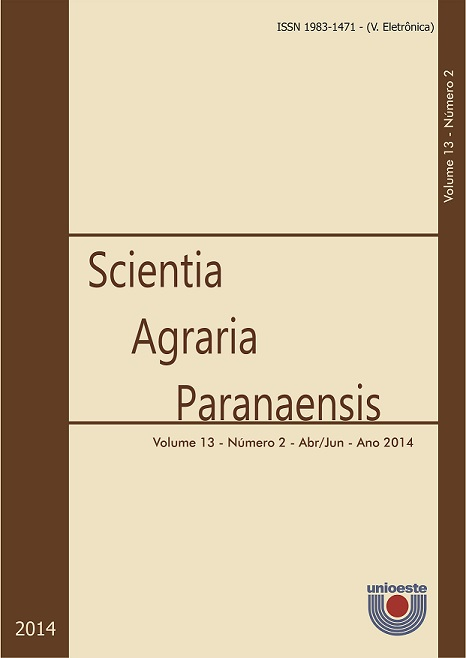Glyphosate rates in the desiccation of Urochloa ruziziensis preceding corn planting
DOI:
https://doi.org/10.18188/sap.v13i2.6722Keywords:
Herbicida, plantio direto, plantas daninhasAbstract
The Urochloa ruziziensis stands as a fodder alternative for the straw development in the tillage system. However, there are few information regarding to the management of desiccation, and the effect of the straw on the weed control. This study aimed at evaluating the efficacy of glyphosate into the management of desiccation of the U. ruziziensis, and the effect of the straw on the weed suppression in corn plantation. The experimental design was a randomized complete block with four replications. The treatments consisted of the following rates of glyphosate: 0; 360; 720; 1,440; 2,160 and 2,880 g ha-1, besides a testimony in fallow, and another in corn without straw. There was no influence of the U. ruziziensis straw in the development and the productivity of corn plants. The dose of 360 g ha-1 of glyphosate provided 100% of of U. ruziziensis desiccation at 28 days after its application, while the remaining straw (6.5 t ha-1) promoted 72.1% of reduction of the weeds population in the fallow portion at 30 days after the corn harvest. We concluded that the glyphosate doses evaluated were effective in the management of the U. ruziziensis desiccation, as well as, it can be an excellent alternative for the integrated management of the weeds in corn tillage system.Downloads
Published
03-07-2014
How to Cite
COSTA, N. V.; PERES, E. J. de L.; RITTER, L.; SILVA, P. V. Glyphosate rates in the desiccation of Urochloa ruziziensis preceding corn planting. Scientia Agraria Paranaensis, [S. l.], v. 13, n. 2, p. 117–125, 2014. DOI: 10.18188/sap.v13i2.6722. Disponível em: https://e-revista.unioeste.br/index.php/scientiaagraria/article/view/6722. Acesso em: 29 jun. 2025.
Issue
Section
Scientific Article
License
Aviso de Direito Autoral Creative Commons
Política para Periódicos de Acesso Livre
Autores que publicam nesta revista concordam com os seguintes termos:
1. Autores mantém os direitos autorais e concedem à revista o direito de primeira publicação, com o trabalho simultaneamente licenciado sob a Licença Creative Commons Attribution que permite o compartilhamento do trabalho com reconhecimento da autoria e publicação inicial nesta revista.2. Autores têm autorização para assumir contratos adicionais separadamente, para distribuição não-exclusiva da versão do trabalho publicada nesta revista (ex.: publicar em repositório institucional ou como capítulo de livro), com reconhecimento de autoria e publicação inicial nesta revista.
3. Autores têm permissão e são estimulados a publicar e distribuir seu trabalho online (ex.: em repositórios institucionais ou na sua página pessoal) a qualquer ponto antes ou durante o processo editorial, já que isso pode gerar alterações produtivas, bem como aumentar o impacto e a citação do trabalho publicado (Veja O Efeito do Acesso Livre).
Licença Creative Commons
Esta obra está licenciada com uma Licença Creative Commons Atribuição-NãoComercial-CompartilhaIgual 4.0 Internacional, o que permite compartilhar, copiar, distribuir, exibir, reproduzir, a totalidade ou partes desde que não tenha objetivo comercial e sejam citados os autores e a fonte.


